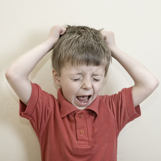Foster Good Behavior
 When you teach a child how to modify their own behavior you are fostering self-respect and respect for others. You are also instilling in them a sense of responsibility and teaching them the importance of rules and consequences.
When you teach a child how to modify their own behavior you are fostering self-respect and respect for others. You are also instilling in them a sense of responsibility and teaching them the importance of rules and consequences.
“What are some ways to prevent behaviors before they occur?”
Reduce distractions: Ever heard of the “out of sight, out of mind” idea. If you don’t want to deal with a tantrum or fight with other children, put things away. Great ways to do this are using curtains, cupboards, and even bins to put toys in or behind when not in use.
Use a schedule: Many children have difficulty understanding the difference between work and play. A visual schedule can designate the work activities are required before receiving a reward or play activity. I like to use “first/then” visual schedules. You can make one on the computer or create a simple one on a dry erase board. The key is to consistently use it and reinforce the appropriate behavior immediately. Draw a line down the center and label one side First and the other Then. Next, draw or make a picture to show what it is you want the child to do and what they will receive for doing it. For example, On the “first” side, I might have a picture of a child brushing her teeth. On the “then” side, I would have the child reading a book with the parent. First you brush your teeth, then we can read a book. The child would not get the book until they brush his/her teeth.
Hand over hand help: If a child can not complete an activity after you give him/her an opportunity to do so, try taking the child’s hand in yours and help him/her successfully complete the task. Always provide your child with the opportunity before offering help and if help is needed still give your child praise for completing the task.
Model appropriate behavior: Children are always watching others and modeling their behavior. If you don’t believe me, ask your child’s teacher about all the funny things your child has repeated from home. When you play a game, with your child take turns. Create opportunities for you to share with your child. Teach your child to count, sing a quiet song, or say the alphabet when they are angry, and try to remember to do this yourself in front of your child. If you are screaming in traffic when your child is in the car with you, how do you think he/she are going to react the next time he/she is frustrated.
Use a behavioral chart: Create a reward system and let your child track his/her progress. I have a stop light on my fridge at home. Each new day my daughter starts on green. She gets one warning before I make her move her name to yellow. She gets one more warning before going to red. Red means she goes straight to time out and loses a preferential toy for the rest of the day. However, if she is on green at bed time, she chooses a toy from her toy chest. The chest may have stickers, candy, small toys, etc. The dollar section at discount stores works great. She can also earn her way back up to green should she falter for going above good behavior. For example, clearing her plate and placing it in the sink without being asked. Rewards do not always have to be tangible either. The treasure chest also holds a ticket for me to play a game of her choice, read an extra night time book, or a trip to the park.
Give choices: When you give a child a choice, you make them feel like they have more control. You provide the choices, but let them make the decision. For example, you need to change into your pajamas, brush your teeth, and kiss Daddy “goodnight”. Which would you like to do first.
Rules: Establish simple clear rules. Provide a visual reminder if needed.
“I tried these Tiffany, and they aren’t working!”
Be firm: Children can be so cute when they are being naughty. It’s hard, but do not smile or laugh as this can send a mixed message. Use a stern voice when saying “no” and do not keep repeating it. If you have said “no” three times, it is time to follow through with the consequence. It is important for children to understand the difference between acceptable and unacceptable behavior.
Be clear: Before saying “no”, remind the child of the consequence if the behavior continues. For example, “If you do not clean up your toys when you are finished, then the toys are going to be put away.”
Be consistent: Consistency is key! Let me say that again…consistency is key and do not think for a minute that your child won’t test you o this one. If we tell a child we are going to do something, and do not follow through, then we haven’t given that child a good reason to stop the behavior. You can be sure, it will continue! It may take a little time for change to be evident when working on behavior, but keep in mind that we may be changing behaviors that have previously been reinforced by ourselves or others.
Withhold contact: Have you ever heard of, “there is no such thing as bad press”. The same goes for attention. Children will sometimes act up just for the attention they receive from adults. They will take cues from the physical, emotional, and physical reactions of adults and then determine whether they will continue or cease the behavior. Make eye contact when telling the child “no”. However during a tantrum, ignoring the behavior often works the best if they are not being injurious. You may re-establish eye contact, hugging, and tickling when appropriate behavior is shown.
Time-out: establish somewhere in your home where the child will stay once the tantrum is over. A timer is great for giving a visual reminder and audio cue. If the child leaves the area, re-start to timer. Be aware that some children try to make a game out of this. I have even had to establish time out zones in the homes of family and friends. This goes back to consistency. Behavior is unacceptable in a variety of environments and time out doesn’t go away because we are somewhere else.
In a perfect world, you want to teach your child haw to control his/her own behavior. Every child is different, though, so certain techniques work better with some children than others. This can even be different between siblings. If you think your child’s behaviors are abnormal, self-injurious, or injurious to others, you should consult your physician or therapist. You need to find what works for you and your child. Just reminder to keep cool and be consistent!
Disclaimer: I hope you enjoyed reading this article. Please remember you are reading this information of your own free will and are taking the information at your own risk. The author is the legal copyright holder of this material it may not be used, reprinted, or published without my written consent. This information is for entertainment and informational purposes only and is not intended to provide or circumvent medical, legal or other professional advice.
Note: To support the site we make money on some products, product categories and services that we talk about on this website through affiliate relationships with the merchants in question. We get a small commission on sales of those products.That in no way affects our opinions of those products and services.


I would love feedback or suggestions on how to limit or decrease behavioral squealing. There’s a video of the behavior in question at http://www.xaviersjourney.org.
I am not the most computer savy person in the world, but I think I just responded to your question on Xavier’s journey blog. Let me know if you don’t find it.